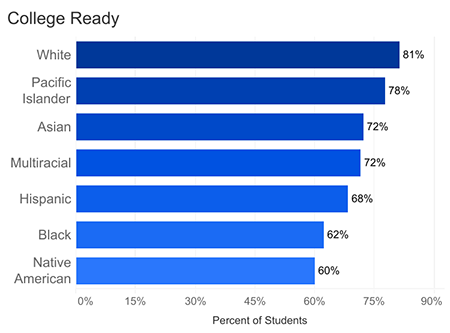Recent Research on College Readiness
Karen Tao, Researcher
March 21, 2022

I introduced recent research in a previous blog post. I want to highlight some of the major findings in this post. This study examines the courses taken and passed by Utah high school students in each subject area and students’ demographic background. The study investigates how course-taking patterns relate to students’ educational outcomes using these data. With data from the Utah State Board of Education (USBE) and Utah System of Higher Education (USHE), this study focuses on Utah high school students from cohorts 2014 to 2017.
Methods
This research first defines college readiness by two conditions:
- Whether a student graduated high school, and
- Whether the student passed an advanced course in high school.
With these two conditions, college readiness is defined as an ordinal variable: college-ready, partially ready, and not ready. Students who met both conditions were “college-ready,” students who met one of the two conditions were “partially ready,” and students who did not meet either condition were “not ready.”
After modeling students’ college readiness using course patterns and demographic data, college readiness is then used as one of the inputs to further model students’ post-secondary outcomes. Post-secondary outcomes in this study include enrollment, awards, intent to study STEM, STEM award, time to enrollment, and time to award.
Major Findings
The first major finding of this research is that demographic background plays a prominent role in students’ college readiness. Students who were English learners, multiracial, or low-income faced decreased odds of college readiness by at least 35%. Specific courses, such as social science and foreign language, increased the odds of being college-ready by no more than 30%. Figure 1 demonstrates the percentage of college-ready students by race.

College readiness plays an important role in students’ post-secondary enrollment and awards. For example, with each increment in college readiness, a student was over five times more likely to enroll at a post-secondary institution and was 58% more likely to receive at least one post-secondary award. However, demographic background continues to play a larger role than course patterns of students’ post-secondary enrollment and awards.
For each additional science course taken, a student was 13% more likely to declare intent to study STEM and 17% more likely to receive an award in a STEM-related field. Though female students had increased odds of enrolling and receiving an award from post-secondary education, they faced decreased odds at declaring an intent to study STEM and receiving a STEM award.
Finally, courses taken or passed in high school did not affect students’ time to post-secondary enrollment or awards by more than 36.5 days, or 0.1 years. Female students were found to enroll and receive an award in a shorter time, and consideration should be given to the cultural norm in Utah. For example, a male student may serve an LDS mission immediately after high school graduation, while female students must be older to serve Latter-day Saint missions. However, religious data were not collected by the USBE or used for this study.
This study highlights the relationship between post-secondary outcomes and high school coursework and demographic characteristics. It is important to understand the values of courses in different subject areas and the disadvantages faced by students in certain minority groups. I invite you to check out the data narrative and look at the interactive graphs for a deeper understanding of this study.